HiSilicon Kirin 970 - Android SoC Power & Performance Overview
by Andrei Frumusanu on January 22, 2018 9:15 AM ESTNPU Performance Tested
To test the performance of the NPU we need a benchmark which currently targets all of the various vendor APIs. Unfortunately at this stage short of developing our own implementation the choices are scarce, but luckily there is one: Popular Chinese benchmark suite Master Lu recently introduced an AI benchmark implementing both HiSilicon’s HiAI as well as Qualcomm’s SNPE frameworks. The benchmarks implements three different neural network models: VGG16, InceptionV3 as well as ResNet34. The input dataset are 100 images which are a subset of the ImageNet reference database. As a fall-back the app implements the TensorFlow inferencing library to run on the CPU. I’ve ran the performance figures on the Mate 10 Pro, Mate 9 as well as two Snapdragon 835 (Pixel 2 XL & V30) devices respectively running on the CPU as well as the Hexagon DSP.
Similarly to the SPEC2006 results I chose to use a more complex graph to better showcase the three dimensions of average power (W), efficiency (mJ/inference) as well as absolute performance (fps / inferences per second).
First thing we notice from the graph is that we can observe an order of magnitude difference in performance between the NPU and CPU implementations. Running the networks as they are on the CPUs we’re not able to exceed 1-2fps and we do so at very heavy CPU power consumption. Both the Snapdragon 835 as well as the Kirin 960 CPUs struggle with the workloads with average power exceeding sustainable workloads.
Qualcomm’s Hexagon DSP is able to improve on the CPU performance by a factor of 5-8x. But Huawei’s NPU performance figures are again several factors above that, showcasing up to a 4x lead in ResNet34. The reason for the different performance ratio differences between the different models is their design. Convolutional layers are heavily parallelisable whilst the polling and fully connected layers of the models must use more serial processing steps. ResNet in particular makes use of a larger percentage of convolution processing for a single inference and thus is able to achieve a higher utilization rate of the Kirin NPU.
In terms of power efficiency we’re very near to Huawei’s claims of up to a 50x improvement. This is the key characteristic that will enable CNNs to be used in real-world use-cases. I was quite surprised to see Qualcomm’s DSP reach similar efficiency levels as Huawei’s NPU – albeit at 1/3rd to 1/4th of the performance. This should bode quite well in terms of the Snapdragon 845’s Hexagon 685 which promises up to a 3x increase in performance.
I wanted to take the opportunity to make a rant about Google’s Pixel 2: I was able to actually run the benchmark on the Snapdragon 835’s CPU because the Pixel 2 devices lacked support for the SNPE framework. This was in a sense maybe both expected as well as unexpected. With the introduction of the NN API in Android 8.1, which the Pixel 2 phones support and use acceleration through the dedicated Pixel Visual Core SoC, it’s natural that Google would want to push usage of Android’s standard APIs. But on the other hand this is also a limitation on the capabilities of the phone by the OEM vendor which I can’t help but compare to the decision by Google to by default omit OpelCL in Android. This is a decision which in my eyes has heavily stifled the ecosystem and is why we don’t see more GPU accelerated compute workloads, out of which CNNs could have been one.
While we can’t run the Master Lu AI test on an iPhone, HiSilicon did publish some slides with reported internally numbers we can try to correlate. Based on the models included in the slide, the Apple A11 neural network IP’s performance should land somewhere slightly ahead of the Snapdragon 835’s DSP but still far behind the Kirin NPU, but again we can't independently verify these figures due to lack of a fitting iOS benchmark we can run ourselves.
Of course the important question is, what is this all good for? HiSilicon discloses that one use-case being used is noise reduction via CNN processing, and thus is able to increase voice recognition rate in heavy traffic from 80% to 92%.
The other most publicised use-case is the implementation in the camera app. The Mate 10’s camera makes use of the NPU to run inferencing to recognize different scenarios and optimize the camera settings based on pre-sets for those scenarios. The Mate 10 comes with a translation app which was developed with Microsoft, which is able to use the NPU for accelerated offline translation, and this was definitely the single most impressive usage for me. Inside the built-in gallery application we also see the use of image classification to create a new section where pictures are organized by content type. The former scenarios where the SoC is doing live inferencing on a media stream such as the camera feed is also the use-case where HiSilicon has an advantage over Qualcomm as employs both a DSP and the NPU whereas Snapdragon SoCs have to share the DSP resources between vision processing and neural network inferencing workloads.
Oddly enough the Kirin 970 has sort of double the silicon IP capable of running neural network efficiently as its vision pipeline also includes a Cadence Tensilica Vision P6 DSP which should be in the same performance class as Qualcomm’s Hexagon 680 DSP, but is currently not exposed for user applications.
While the Mate 10 does make some use of the NPU it’s hard to argue that it’s a definitive differentiating factor for the end-user. Currently neural network usage in mobile doesn’t seem to have the same killer-applications that they have in automotive and security camera sectors. Again this is due to the ecosystem being its early days and the Mate 10 among the first devices to actually offer such a dedicated acceleration block. It’s arguable if it’s worth it for the Kirin 970 to have implemented such a piece and Huawei is very open about the fact that it’s reaching out to developers to try and find more use-cases for the silicon, and at least Huawei should be lauded for innovating with something new.
Huawei/Microsoft's translation app seemed to be the most distinguished experience on the Mate 10 so maybe there’s more non-image based use-cases that can be explored in the future. Currently the app allows the traditional snapshot of a foreign language text and then shows a translated overlay, but imagine a future implementation where it’s able to do it live from the camera feed and allow for an AR experience. MediaTek at CES also showed a distinguishing use-case of using CNNs: for video conferencing the video encoder is fed metadata on scene composition by a CNN layer doing image recognition and telling the encoder to use finer-grained block sizes where a user’s face would be, thus increasing video quality. It’s more likely that neural network use-cases will slowly creep up with time rather than there being a new revolutionary thing, as more devices will start to incorporate such IPs and they become more widespread so will developers be more enticed to find uses for them.


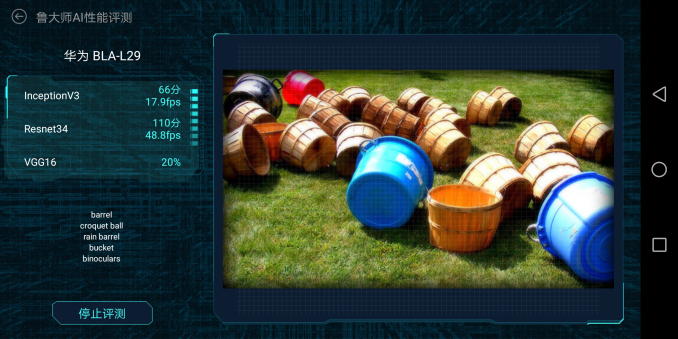
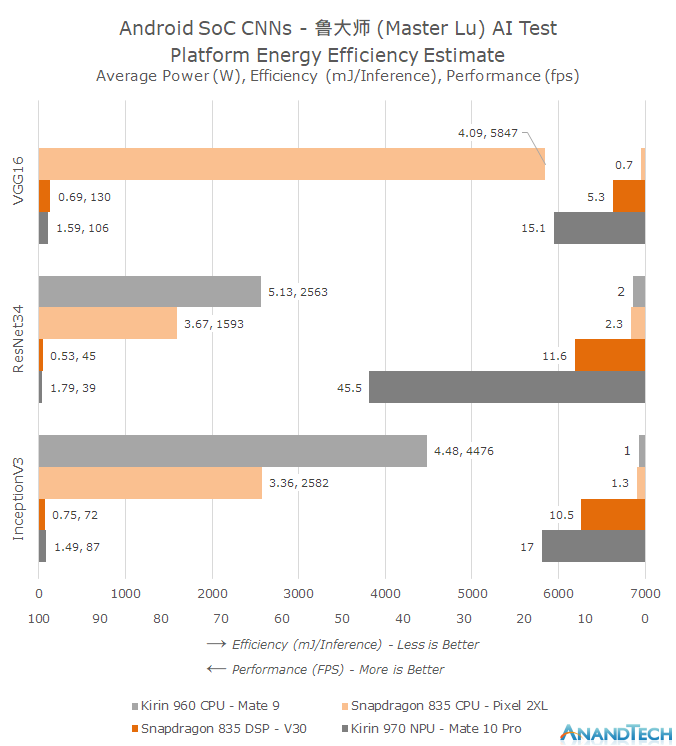
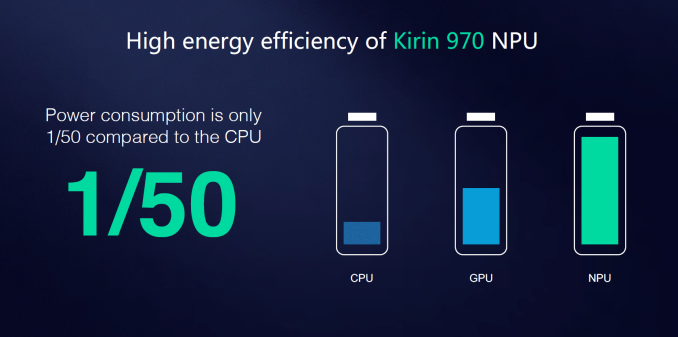
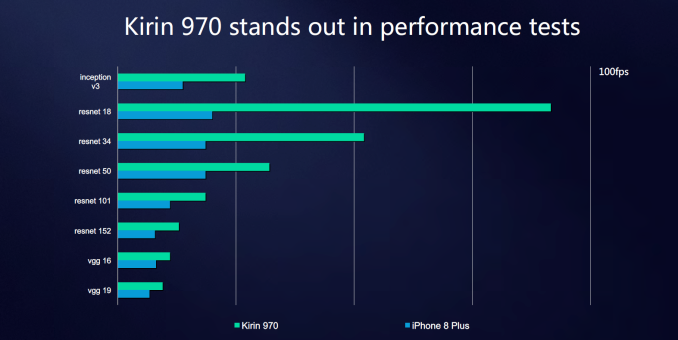

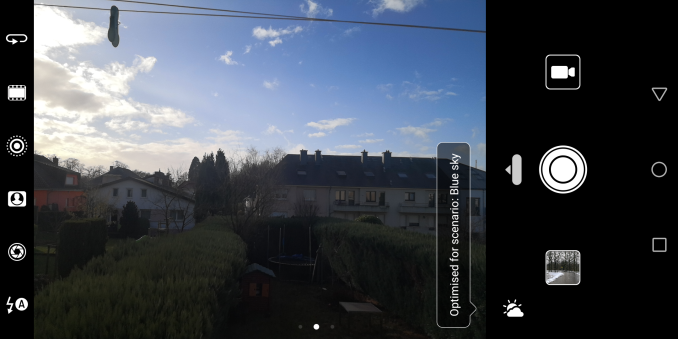
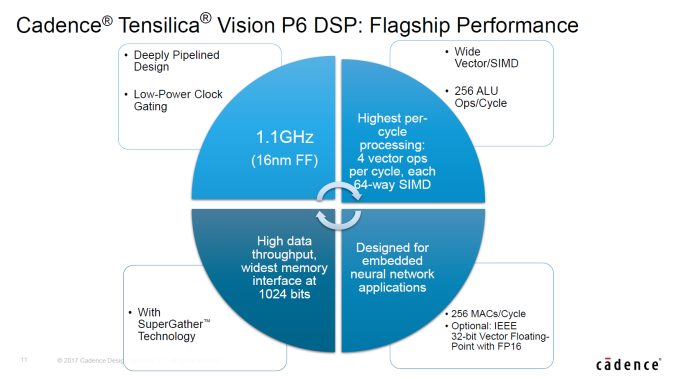








116 Comments
View All Comments
lilmoe - Monday, January 22, 2018 - link
Unfortunately, they're not "fully" vertical as of yet. They've been held back since the start by Qualcomm's platform, because of licensing and "other" issues that no one seems to be willing to explain. Like Andrei said, they use the lowest common denominator of both the Exynos and Snapdragon platforms, and that's almost always lower on the Snapdragons.Where I disagree with Andrei, and others, are the efficiency numbers and the type of workloads used to reach those results. Measuring efficiency at MAX CPU and GPU load is unrealistic, and frankly, misleading. Under no circumstance is there a smartphone workload that demands that kind of constant load from either the CPU or GPU. A better measure would be running a actual popular game for 30 mins in airplane mode and measuring power consumption accordingly, or loading popular websites, using the native browser, and measuring power draw at set intervals for a set period of time (not even a benchmarking web application).
Again, these platforms are designed for actual, real world, modern smartphone workloads, usually running Android. They do NOT run workstation workloads and shouldn't be measured as such. Such notions, like Andrei has admitted, is what pushes OEMs to be "benchmark competitive", not "experience competitive". Apple is also guilty of this (proof is in the latest events, where they're power deliver can't handle the SoC, or the SoC is designed well above sustainable TDP). I can't stress this enough. You just don't run SPEC and then measure "efficiency". It just doesn't work that way. There is no app out there that stresses a smartphone SoC this much, not even the leading game. In the matter of fact, there isn't an Android (or iPhone) game that saturates last year's flagship GPU (probably not even the year before).
We've reached a point of perfectly acceptable CPU and GPU performance for flagships running 1080p and 1440p resolution screens at this point. Co-processors, such as the decoder, ISP, DSP and NPU, in addition to software optimization are far, FAR more more important at this time, and what Huawei has done with their NPU is very interesting and meaningful. Kudos to them. I just hope these co-processors are meant to improve the experience, not collect and process private user data in any form.
star-affinity - Monday, January 22, 2018 - link
Just curious about your claims about Apple – so you think it's a design fault? I'm thinking that the problem arise only when the battery has been worn out and a healthy battery won't have the problem of not sustaining enough juice for the SoC.lilmoe - Monday, January 22, 2018 - link
Their batteries are too small, by design, so that's the first design flaw. But that still shouldn't warrant unexpected slowdowns within 12-18 months of normal usage; their SoCs are too power hungry at peak performance, and the constant amount of bursts was having its tall on the already smaller batteries that weren't protect with a proper power delivery system. It goes both ways.Samus - Monday, January 22, 2018 - link
Exactly this. Apple still uses 1500mah batteries in 4.7" phones. When more than half the energy is depleted in a cell this small, the nominal voltage drops to 3.6-3.7v from the 3.9-4.0v peak. A sudden spike in demand for a cell hovering around 3.6v could cause it to hit the low-voltage cutoff, normally 3.4v for Li-Ion, and 3.5v for Li-Polymer, to prevent damage to the chemistry the internal power management will shut the phone down, or slow the phone down to prevent these voltage drops.Apple designed their software to protect the hardware. It isn't necessarily a hardware problem, it's just an inherently flawed design. A larger battery that can sustain voltage drops, or even a capacitor, both of which take up "valuable space" according to Apple, like that headphone jack that was erroneously eliminated for no reason. A guy even successfully reinstalled a Headphone jack in an iPhone 7 without losing any functionality...it was just a matter of relocating some components.
ZolaIII - Wednesday, January 24, 2018 - link
Try with Dolphine emulator & you will see not only how stressed GPU is but also how much more performance it needs.Shadowfax_25 - Monday, January 22, 2018 - link
"Rather than using Exynos as an exclusive keystone component of the Galaxy series, Samsing has instead been dual-sourcing it along with Qualcomm’s Snapdragon SoCs."This is a bit untrue. It's well known that Qualcomm's CDMA patents are the stumbling block for Samsung. We'll probably see Exynos-based models in the US within the next two versions once Verizon phases out their CDMA network.
Andrei Frumusanu - Monday, January 22, 2018 - link
Samsung has already introduced a CDMA capable Exynos in the 7872 and also offers a standalone CDMA capable modem (S359). Two year's ago when I talked to SLSI's VP they openly said that it's not a technical issue of introducing CDMA and it'll take them two years to bring it to market once they decide they need to do so (hey maybe I was the catalyst!), but they didn't clarify the reason why it wasn't done earlier. Of course the whole topic is a hot mess and we can only speculate as outsiders.KarlKastor - Thursday, January 25, 2018 - link
Uh, how many devices have shipped yet with the 7872?Why do you think they came with a MDM9635 in the Galaxy S6 in all CDMA2000 regions? In all other regions their used their integrated shannon modem.
The other option is to use a Snapdragon SoC with QC Modem. They also with opt for this alternative but in the S6 they don't wanted to use the crappy Snapdragon 810.
It is possible, that Qualcomm today skip their politics concerning CDMA2000 because it is obsolete.
jjj - Monday, January 22, 2018 - link
Don't forget that Qualcomm is a foundry customer for Samsung and that could be why they still use it.Also, cost is a major factor when it comes to vertical integration, at sufficient scale integration can be much cheaper.
What Huawei isn't doing is to prioritize the user experience and use their high end SoCs in lower end devices too, that's a huge mistake. They got much lower costs than others in high end and gaining scale by using these SoCs in lower end devices, would decrease costs further. It's an opportunity for much more meaningful differentiation that they fail to exploit. Granted, the upside is being reduced nowadays by upper mid range SoCs with big cores and Huawei might be forced into using their high end SoCs more as the competition between Qualcomm and Mediatek is rather ferocious and upper mid becomes better and better.
Got to wonder about A75 and the clocks it arrives at ... While at it, I hope that maybe you take a close look at the SD670 when it arrives as it seems it will slightly beat SD835 in CPU perf.
On the GPU side, the biggest problem is the lack of real world tests. In PC we have that and we buy what we need, in mobile somehow being anything but first is a disaster and that's nuts. Not everybody needs a Ferrari but mobile reviews are trying to sell one to everybody.
HStewart - Monday, January 22, 2018 - link
This could be good example why Windows 10 for ARM will failed - it only works for Qualcomm CPU and could explain why Samsung created Intel based Windows TabletsI do believe that ARM especially Samsung has good market in Phone and Tablets - I love my Samsung Tab S3 but I also love my Samsung TabPro S - both have different purposes.